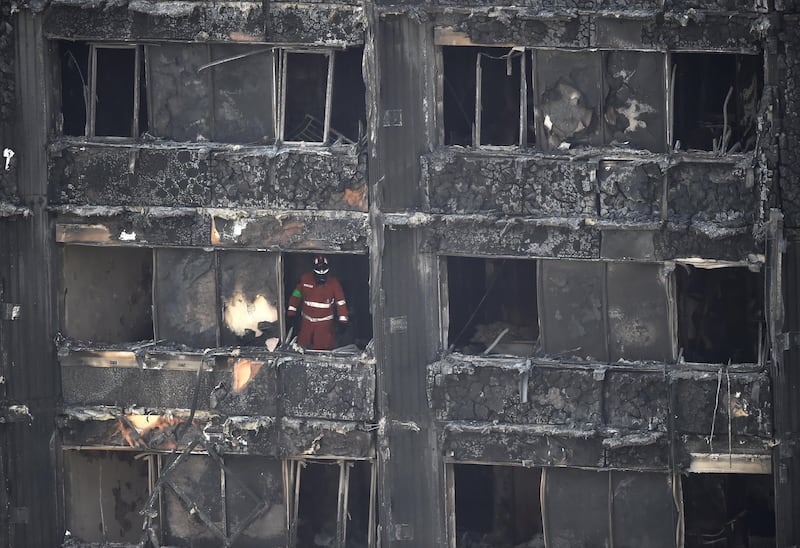As the sun rose on the still burning Grenfell Tower on the morning of Wednesday June 14, it soon became clear that the high-rise's blackened hulk wasn't just a blot on the West London skyline, but that it also represented a stain on the collective conscience of Britain's political elite.
The timing of the disaster was everything. Not only did the fire start in the early hours of the morning, trapping many of the block's residents as they slept, but it also occurred less than a week after a general election that had exposed the extent of the UK's bitter political and social divisions.
In this context, the Grenfell Tower fire quickly became a signifier for the nation’s travails as the issues of class, inequality and austerity that had set the tone for the latter stages of a political campaign that fed into the discussion and analysis of a catastrophe for which there is still no death toll but in which 80 people are believed to have perished.
“If you cut local authority expenditure, then the price is paid somewhere,” the leader of the Labour Party, Jeremy Corbyn, told the British broadcaster ITV News.
While the investigation focused on the role of the tower's cladding in fuelling the blaze, residents and analysts began to conflate the government's arm's length approach to the privatisation of social housing and with more profound questions of honesty and morality, decency and transparency in a manner that echoed an older set of aesthetic debates, sometimes knowingly, sometimes not.
Those in the knowing camp surely included The Financial Times' architecture and design critic Edwin Heathcote. Appearing on the BBC's The World Tonight radio programme less than 24 hours after the blaze, the journalist and former architect outlined the difference between the utopian impulse that had informed the design and construction of high-rises such as the Grenfell Tower and the market-driven desire for "prettification" that led to their cladding in "cheap, tacky materials that also turn out to be lethal".
“[These] towers appeared on the horizon as a very visible, visual symbol of the welfare state, they are the concretisation of the welfare state, but the downside is that when they were neglected, they also became a visual symbol of that neglect,” the journalist told the BBC’s Ritula Shah.
“It’s a very curious moment we’re in now because the cladding is covering up the concrete finish which has actually now itself become super fashionable,” he added.
“There is a huge, growing appreciation of the raw, brutal nature of concrete, so we’re in this moment when buildings that are still associated with the social ills … are actually rather fashionable in themselves.”
That vogue for unadorned concrete architecture is the subject of a lavishly illustrated new book, Ornament is Crime, by Matt Gibberd and Albert Hill (Phaidon, 2017) whose title now resonates with an unforeseen intensity following the Grenfell Tower blaze on June 14 and other recent cladding-related fires in London, Melbourne and Dubai.
Using photographs of historic and contemporary Modernist houses alongside quotes from the likes of the 19th century design reformer Owen Jones, Louis Sullivan – the American architect who first coined the phrase “form as ever follows function” – and fashionable contemporary designers such as David Adjaye, the book charts the influential intellectual tradition that associates decoration with moral and aesthetic dishonesty while setting out to show how “this most trailblazing of architectural styles is still thriving in the twenty-first century”.
As Gibberd admits in his introduction to the text, the only essay in a volume that feels more like a fashion designer's mood board than a book, Ornament is Crime borrows its title from a lecture and subsequent essay, Ornament and Crime, that was first delivered in 1910 by the influential Austro-Hungarian architect, writer and thinker Adolf Loos.
Read today, much of Loos' essay reads like a psychotic rant, but that didn’t prevent it from becoming a fixture in 20th-century design education or reduce its influence on mid-century Modernists such as Loos’ pupil, the California-based European émigré Richard Neutra, and through them contemporary designers such as Frank Gehry, Jean Nouvel and Rem Koolhaas.
As Gibberd and Hill admit on the website for The Modern House, their property agency that specialises in the sale of Modernist homes, Loos is not the only historic architect to whom they're in debt.
Their business takes its name from a 1934 book by the British Modernist FRS Yorke, The Modern House, and it is in the light of this influence, rather than Loos's, that Ornament is Crime is understood best.
Yorke was a close friend of Gibberd's illustrious architect grandfather, Frederick Gibberd, who designed Liverpool's iconic post-war Catholic cathedral. Yorke's campaigning text used 14 pages of black-and-white photographs to introduce British readers to the masterpieces of interwar Modernism. Three years later, in 1937, Yorke and Frederick Gibberd collaborated on a second volume, The Modern Flat.
Yorke and Gibberd both succeeded in making the transition from being inter-war aesthetic radicals to becoming members of the post-war architectural establishment.
Prosperous and well-connected, Yorke built his reputation designing buildings for the welfare state but he retained distinctly bourgeois habits, as did Gibberd, the designer of Harlow New Town in Essex and the London Central Mosque in Regent’s Park, who “enjoyed the trappings of his success, and was chauffeured around in a vintage drophead Rolls Royce”.
Gibberd and Hill's Ornament is Crime emerges from a similarly contradictory and bourgeois intellectual space. Despite being written and compiled from a perspective of expertise – Matt Gibberd studied the history of art and architecture before becoming a senior editor at The World of Interiors, while Albert Hill was the design editor at Wallpaper* magazine – it focuses on private residences that are not only luxurious but are also the stuff of the authors' daily bread.
As Matt Gibberd admits in the introduction to Ornament is Crime, several of the houses that feature in the book have been sold by The Modern House and one suspects that they won't be the last.
By choosing to concentrate their focus on private residences rather than public works, which would have supported the book’s argument just as well, the authors have essentially recreated their business model in print, turning their genuine knowledge and love of architecture into the stuff of commerce and real estate.
There’s nothing inherently wrong with that, but in a post-Grenfell Tower world it makes for an uncomfortable read.
Ornament is Crime: Modernist Architecture by Matt Gibberd and Albert Hill is published by Phaidon





